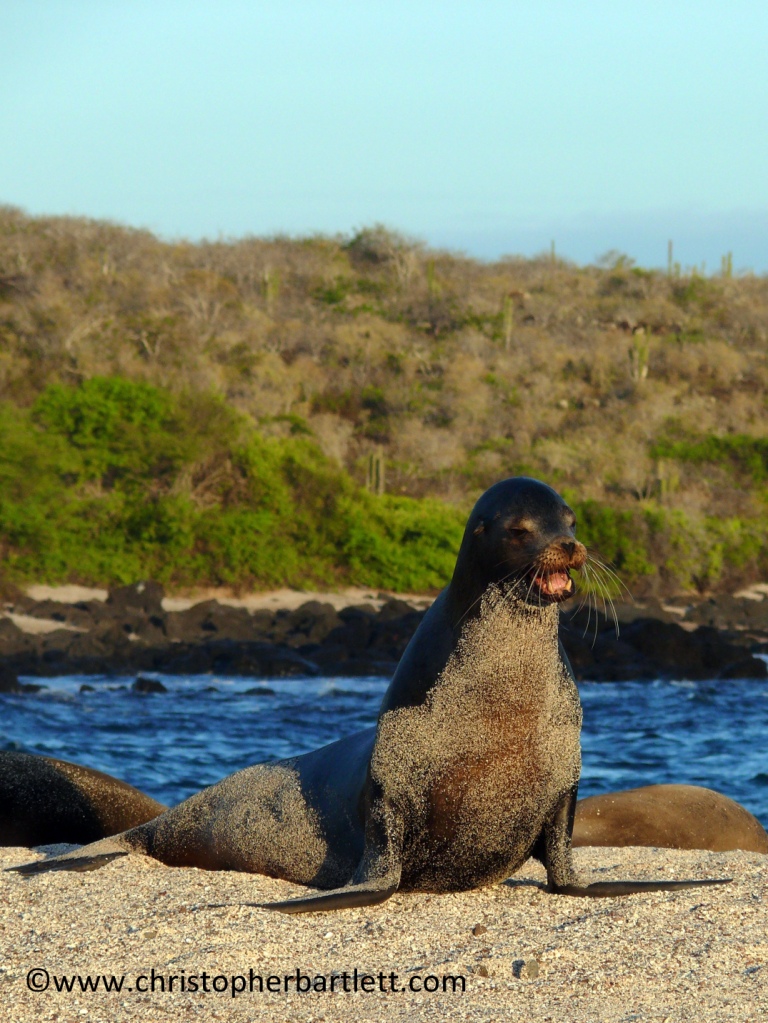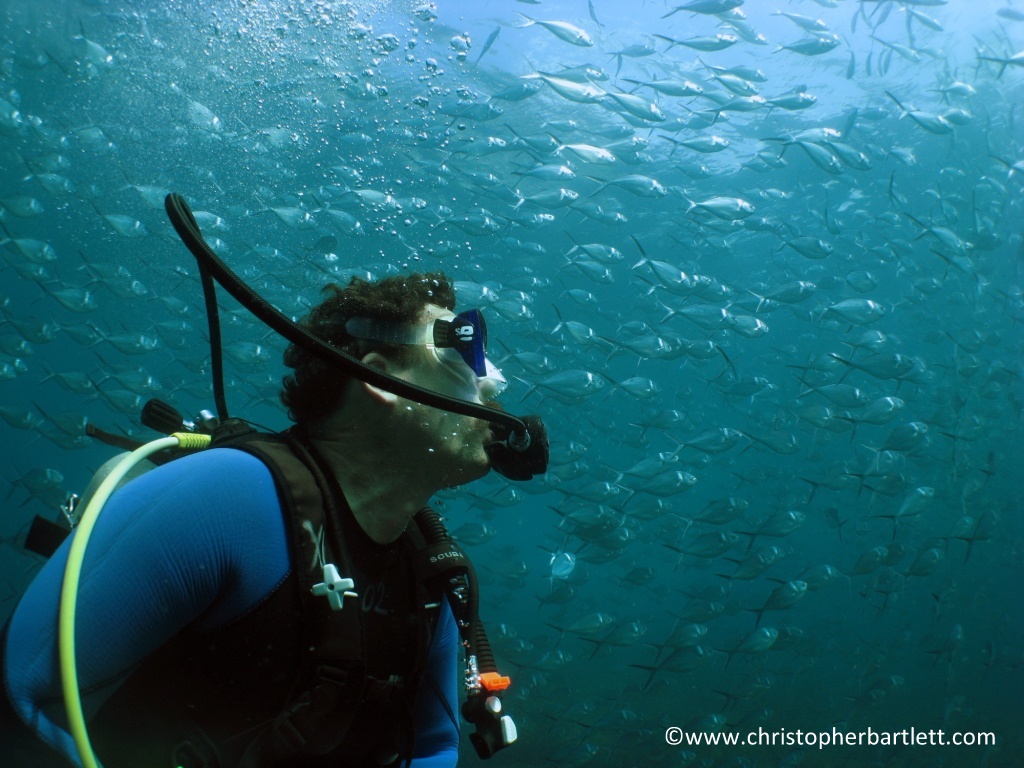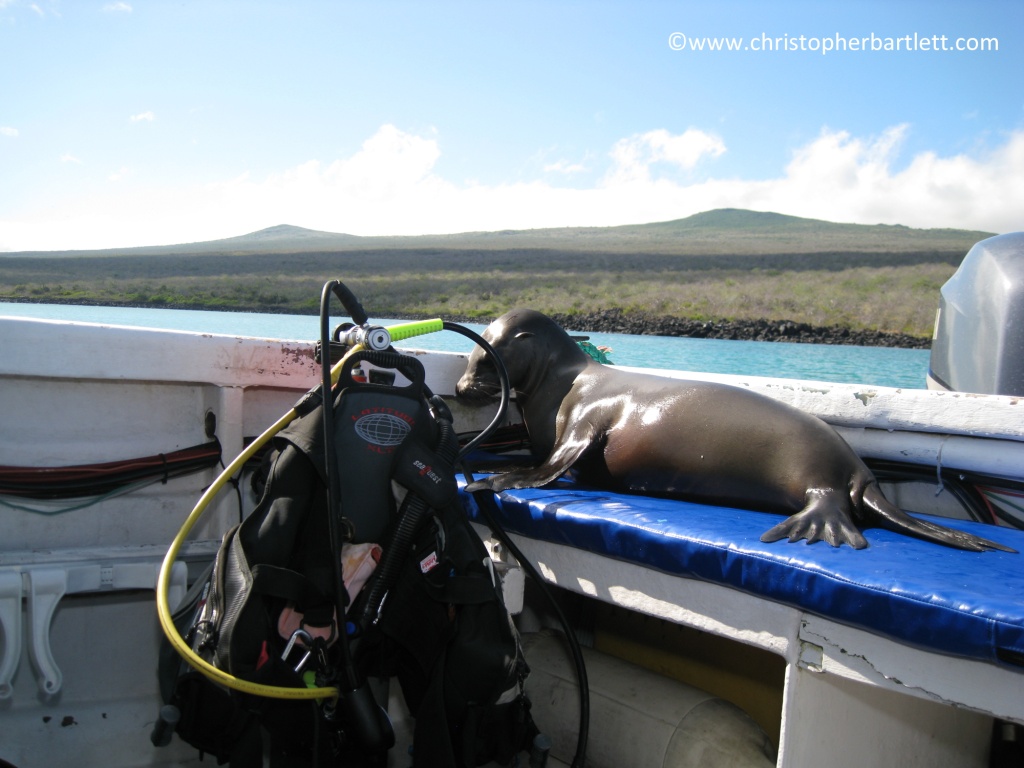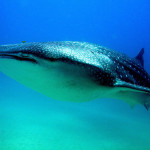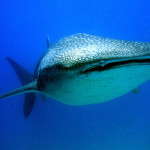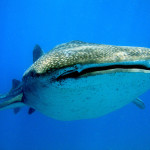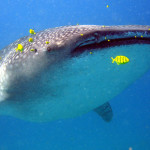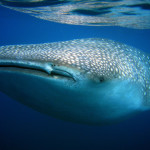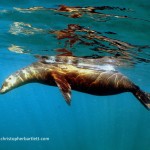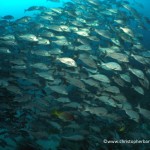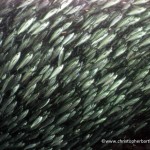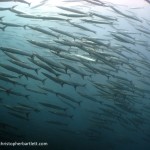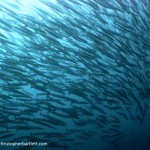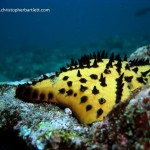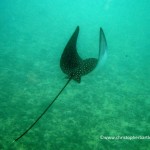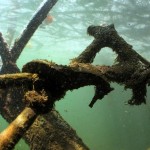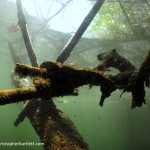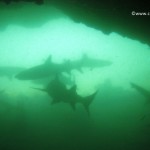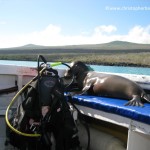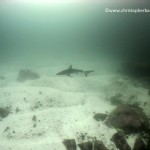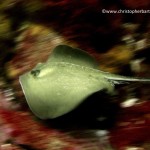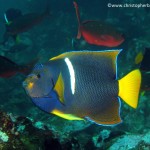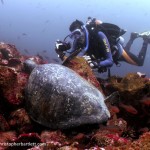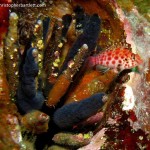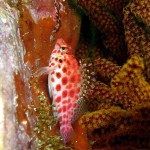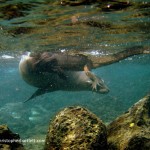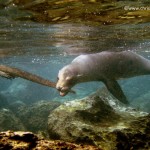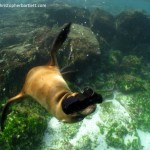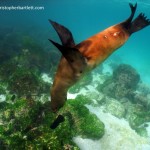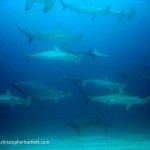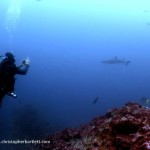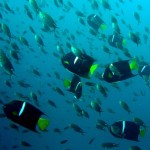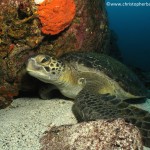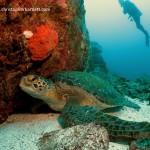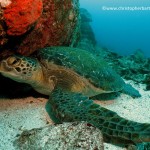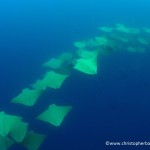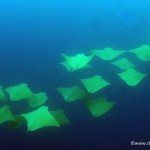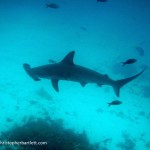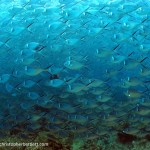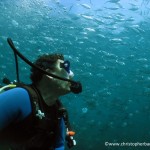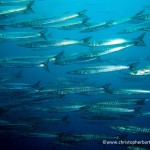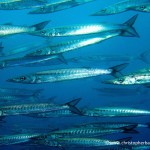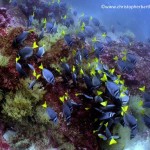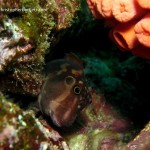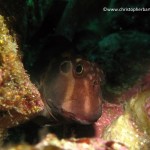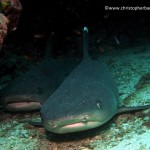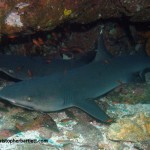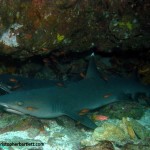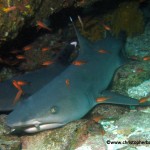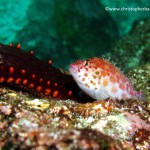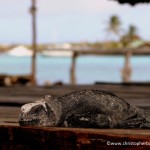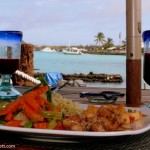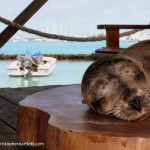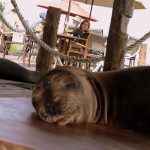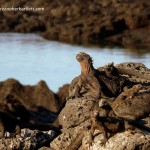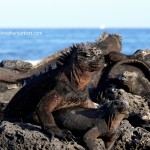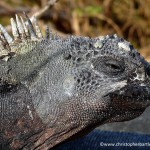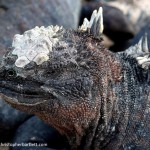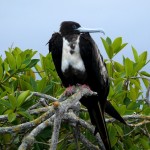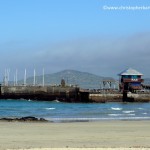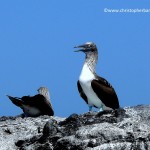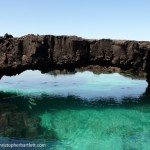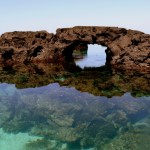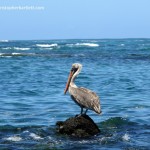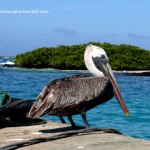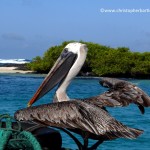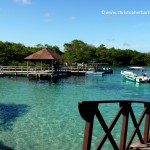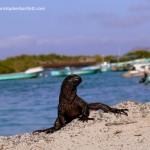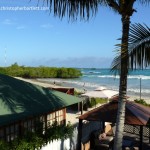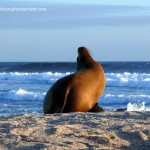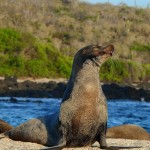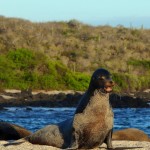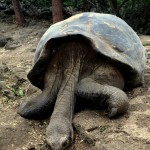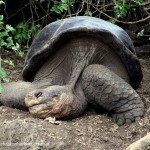Unlike Max I hadn’t worn my wolf suit, or made mischief of one kind or another. I hadn’t been sent to my bedroom for it to transform into an island of magical monsters, only reachable after a year of sailing. I wouldn’t want to spend that long on a boat, so I behaved(ish) and looked into going to the Galapagos and spending my nights tucked up on dry land.
Simon’s left arm shot out, index finger extended, and he clenched his right fist and stuck it on the side of his head. I scanned left and right fast, peering through my mask into the milky blue water. “Where?! Where?!” my brain implored. “There!!!” my eyes answered. “At last” I smiled to myself with relief, bringing by camera up to eye level as the school of scalloped hammerheads cruised past 10 metres away, swaying over the sandy bottom of the underwater caldera in the middle of the site called Gordon Rocks. I now knew that Gordon certainly did, providing me, and many other divers over the years, with their first sightings of this oddly but brilliantly-shaped fish.
In the past I’d searched for hammerheads in the Red Sea and in South Africa on five blue dives with a solitary, faint blur my sole reward, and coming to the Galapagos they were on the top of my fish wish list. They are one of the emblematic Galapagan species after all; the t-shirt shops of Puerto Ayora on Santa Cruz, the most-inhabited island of the archipelago, were draped in them, and along with the giant tortoise formed the logo of the Galapagos National Park. Yet I had been on the islands for a week, investigating land-based diving and nature tours with Red Mangrove’s suite of luxury lodges, and tacky miniatures and gaudy prints were all I’d seen. In terms of diving, the best had definitely been saved till last.
Not that the rest of the diving had been poor, we’d just been a bit unlucky. Gordon Rocks is normally the first or second diving destination from Santa Cruz island on Red Mangrove’s land-based island-hopping diving itinerary, but due to a last-minute flight cancellation, my partner and I missed Gordon Rocks on what should have been our first day of an eight-day tour whilst we occupied ourselves in Guayaquil on the mainland for an extra twenty four hours. Still, we had planned to have plenty of days “spare” on Santa Cruz looking at diving from Puerto Ayora, so we arranged to catch up at the end.
I also thought that I was on a bit of a lucky streak; I was randomly upgraded to first class on the flight to Guayaquil to meet up with Imi, and we were both upgraded for the two-hour A320 Tamé flight to Isla Baltra. Being greeted with cool water and chilled face towels by our escort enhanced the good vibe, as did the friendly banter with our guide on the 200-metre ferry ride and 42-kilometre drive across Santa Cruz island. By the time we had checked into our funky room metres from Puerto Ayora’s gently lapping bay, seen marine iguanas basking on the restaurant deck, snapped a sea lion snoozing in the shade on a coffee table, and eaten some tender calamari and chicken with perfectly steamed veg, we were naturally feeling pretty positive.
A post lunch-trip to snorkel with some sea lions resulting in a couple of half-decent pics, a boat ride to the white sands of Tortuga Bay and a guided nature walk to see the marine iguanas, Sally Lightfoot crabs, and large cacti growing from volcanic rock did nothing to dampen the feeling that everything would just fall perfectly into place, the late flight cancellation and re-jigged schedule a minor blip. After a brief meeting with our dive guide for the following day and a candlelit dinner, I was rocked to sleep by the wash of the ocean, dreaming about big fish with funny heads.
On the boat ride out to Sante Fé island the next morning, having left the busy cargo ships, numerous moored liveaboards and plentiful small craft behind, we were regaled with the previous day’s missed sightings of a manta, eagle rays, stingrays, whitetip reef sharks, and of course hammerheads. A reef manta (Manta alfredi) breached to the side of the boat, as if to say “come on, jump in, we’re waiting for you”.
Except they weren’t. Nature, of course, works to its own schedule. There was a six-metre cave swim-through, a group of silvery grunts, and a school of barracuda in the distance. “Never mind” I thought, “it was fine for a return to the water” but I was a little disappointed. I had been expecting the 10 -15 metre viz and the rocky underwater landscapes. Although the Galapagos are in the Pacific and on the equator, the water temperature drops to the low 20s, too cold for much coral growth, due to the passing Humboldt current coming up from the south. But I had also been expecting more action.
It is also about expectations – maybe I’d misread the hype – I had been expecting big stuff: sharks, big schools of fish and classrooms of rays, turtles, sea lions and marine iguanas. The two fellas from Quito doing DSDs and their two OW buddies naturally thought the whole experience had been grand. During the surface interval we motored back towards Puerto Ayora and descended upon a shallow site called La Loberia (lobo del mar being a sea lion in Spanish). The viz was at most 10 metres and full of fish poo, but we soon saw why we were here.
Two sea lions dived down from the surface, spinning and turning with incredible agility, zipping around us like underwater break-dancers as we approached a dark shadow in front of us. The other divers were ahead and, as I turned to take a snap, went in and disappeared. As I approached I saw that it was in fact a huge school of the endemic black-striped salema (Xenocys jessiae). Where were the others? I moved forward. The fish parted a little, but stayed inches from me. I went in some more and it got dark. I looked around and saw that they had surrounded me, I was engulfed in a giant amorphous blob of fish. I could hear the DM rattling his shaker, trying to guide me on. I tapped back on by strobe arm. I swam on and we met up, four divers in a zillion sardine-sized fish. Incredible. When we emerged back into daylight, more sea lions came to play briefly, then sped off, no doubt to get a stripy snack.
In the afternoon we were escorted to a small cruiser and sped off towards Isla Isabela, the largest of the four inhabited islands. As the cabin looked pretty full with 16 passengers we asked to sit on the flybridge with some cargo. We chatted to the skipper in dodgy Spanish as he opened the twin 300 HP four-strokes up for the two-hour crossing.
Approaching Puerto Vilamil we slowed to little more than an idle as the skipper skirted around the inside of the bay formed in the lava rocks. The contrast with Puerto Ayora was considerable; with little more than 3000 inhabitants, our home for the next four days was sleepy and quiet under the afternoon sun, our small boat the largest in the port. As soon as our feet hit the wooden pontoon of the port we were guided to a “panga”, a narrow speedboat, and taken for a snorkel in the shallow lagoon. The tide was going out, lifting up the sandy bottom, but not enough to obscure a spotted eagle ray and a small whitetip reef shark. I thought the tide of my luck was swinging back the other way.
Over a gourmet dinner, our dive guide for the morrow, Paco, seemed to think so. “95% chance of hammerheads at Isla Tortuga” he stated confidently before drawing a map of the dive site. It would be a fast drift dive around the outside edge of a crescent-shaped island that was once a volcano, with a few interludes hiding behind outcrops of cooled lava to hopefully watch the hammers go by and break my duck. Of course you know that I didn’t. We were accompanied by a huge school of Galapagos barracuda most of the first dive (good food for sharks), there were plenty of King Angelfish (who are partial to cleaning sharks), eagle rays and stingrays on the second dive (more shark food), four green turtles, and three schools of razor surgeonfish. The current was fun, and the diving was good, despite mediocre viz, and back in the aquamarine bay we saw more turtles and stingrays, and the world’s smallest and only tropical penguin; the cute Galapagos penguin.
After a dry day spent walking up Sierra Negra, the world’s largest active volcano crater, spanning an impressive 11 kilometres from side to side, we set off along the coast for Los Tuneles. As we bombed along we passed more than twenty turtles and five mantas on the 30-minute ride. Skipper Julio displayed admirable skill to get us through some rough surf before threading us through the treacherous lava rock formations to an astonishing haven. Los Tuneles is a maze of arches formed by lava tunnels in some of the most beautiful water I have seen. There were turtles galore to snorkel with, as well as juvenile eagle rays, stingrays, and the odd barracuda. By the time we were done we estimated that we had seen at least 50 turtles either from the boat or in the water.
Julio’s prowess wasn’t limited to tricky boat manoeuvres either. At Elfinado he donned mask and fins and found two arches occupied by close to a dozen whitetips, and then led us to the mangroves to show us his secret seahorse. Tail wrapped around a branch, with the sunlight filtering through the film-covered surface the view was ethereal. Just below a turtle snoozed, half-under a ledge on a bed of leaves in an almost autumnal composition. To cap a great day, he pointed us to narrow, shallow channel close to the port and told us to snorkel carefully along the top. The incoming tide made the water murky, but a couple of metres below us we made out first one, then two, then another now-familiar whitetip. As we pulled ourselves along the sides of the 100-metre long one-metre wide channel, we could see that the bottom was carpeted with them. My notes say “Photography value zero, thrill value high”. On a slack tide with some viz, it would have been amazing.
After a fun 90-minute flight on a 10-seater Norman Britten Islander to San Cristobal island we dropped our bags off and were whisked off on a short walk up to a water-filled crater to learn more about frigate birds and down to another beach popular with sea lions, before sorting out our gear at the dive centre for the next day’s diving with DM Jimbo. Over dinner he told us about Kicker Rock (a.k.a. El Leon Endormido), talking up our chances of seeing hammerheads and the endemic Galapagos shark.
As Imi had decided to put on some additional neoprene, we stopped at Isla Lobos for a quick check dive. While we suited up, a rather cheeky sea lion hopped onto the boat and started checking out my gear for me and followed us into the water for a quick play around on the sandy bottom of the bay.
Alongside the lion-shaped rock, we rolled in and entered the channel formed by a 20-metre gap towards its western tip. Sheltered from the sun’s rays, the sea was grey as we hovered above the sandy peering ahead. A couple of stingrays were resting on the bottom and a third flitted past. We lay in the sand and waited and shortly three Galapagos sharks swam through the 25-metre deep channel. A first for me; they are quite small but beautifully-shaped creatures, and move with their natural predatory grace. I couldn’t help wondering whether they would be followed by hammerheads. A couple more swam by, followed by a couple of blacktips. “Martillo, martillo, aqui martillo” I sang in my head, but none came. The vertical wall along the outside flank of the rock was madly mottled with blue and orange sponges, pencil urchins resting wherever they found a nook, often with a small hawkfish or the stunning blue and red of the endemic whitetailed damselfish juvenile. The sea was full of fish with king angelfish and in abundance, streamer hogfish and gringos (creole fish). We returned to the wall for a second diving, after going to the far tip looking for hammerheads (obsessed, me?) in the current, and were rewarded with more fish soup and five green turtles no less. Despite being hammerless that morning, the Sleeping Lion was certainly awake underwater.
After lunch back in the sheltered waters of Isla Lobos, Jimbo took us for a snorkel along the rocky edge to look for marine iguanas. We weren’t disappointed, as well as more damsels and razor surgeonfish, we quickly found an iguana trying to escape the playful attentions of a sea lion that was pulling its tail in a slapstick wrestling contest. Once that act was over, a pair of sea lions popped up, darting and whirling in random directions like a firework display run by delinquent kids. As the finale, yet another smooth, brown underwater puppy whizzed into view, a black object with a shiny end in its mouth. Like a Covent Garden juggler it tossed it up, watched it sink a few metres, flitted down to catch it, before doing it again. But what was it juggling? After a few minutes our entertainer swam right up to my lens, looked at me, and placed the object on the sand below me before swimming off. I dived down and picked up an immaculate, but batteryless, 120-dollar dive torch. Amazing. Was this the same curious and cheeky chappy from this morning who had borrowed a toy from another diver?
That wasn’t the end to the day though. No sooner back on shore, we were greeted by our guide who took us to the island’s visitor centre and up to frigate bird hill for more great views and wildlife info before a quick dinner with our host Daniella and a deep sleep. San Cristobal had been pretty action-packed, so they next day we chilled out firstly on the boat transfer back to Puerto Ayora on Santa Cruz, and then walking around the Charles Darwin Research Station, attempting to slow down to the same pace as the old giant tortoises, the most well-known of them being the century-old Lonesome George, the last survivor of a species decimated by human activity.
And so we were finally doing day one on day eight, about to roll into the small volcanic crater that makes up Gordon Rocks. The overcast day and choppy seas did nothing to make me think that I’d come away with much. How wrong I was. More than a dozen hammerheads cruised past just above the sandy crater bottom as soon as we had descended the 28-odd metres to get there. BINGO! As we did a circuit around the inside (and through some crazy thermoclines that went from 21 to 17 degrees C) there were swimming whitetip reef sharks, turtles, and large schools of king angelfish and razor surgeonfish again, basslets and butterflyfish, all good cleaner fish for large species.
Gordon Rocks really did rock. It was a fitting finale to a most excellent first week as we moved into budget accommodation in the centre of town, a street back from the sea, for the final six days.
For 35 dollars a night we found a double with air-con of sorts (it was either on freezing or warm), private bathroom, and breakfast. There are plenty of restaurants serving main courses from $8, small stores sell fruits and snacks, there is a small supermarket down by the port, and lunch is provided on dive boats.
The following day we returned to Gordon Rocks and saw more hammerheads, whitetips, friendly turtles, and even a sea lion. The vertical currents and surge can definitely be quite a challenge for inexperienced divers, and the cold currents can be core-chilling. It’s quite common for divers to come up after 30 minutes as the combination of the above and going down to 30 metres sucks up their air. One fellow diver, an out of practice yet ex-commercial diver with 2000+ dives, was done in 19 minutes. For those who can hang around and check out the outside walls, the rewards are excellent though. Although my camera had already fogged up, I got to marvel at a huge, slow-moving school of countless one-metre-long snapper at 10 metres and then a wahoo as we surfaced, and on another safety stop saw over a hundred golden cow rays cruise past. They also put in a brief appearance on another visit to Santa Fe, as did a massive school of pompano that encircled us in a silvery fishy cylinder, and yet more Galapagos barracuda.
We also went to North Seymour with Galapagos Sub-Aqua, found more stingrays, marbled rays, eagle rays, a manta silhouetted above us in the gloom, and several pairs of whitetips resting under overhangs, the dives culminating in some exciting fast drifts over shallow water on the safety stops.
Whenever I think about Gordon Rocks my mouth curls into a smile. It epitomises the Galapagos for me. Even on a gloomy day it reflects the unique and enchanting nature of the archipelago’s diverse nature, its strong currents symbolising the challenges ahead, and its diverse life reminders of what we have to lose.
Travel info:
We were superbly hosted by Red Mangrove for our first week – see: http://www.redmangrove.com who have a range of off-the-shelf itineraries, and who also do tailor-made trips and can cater for a mixed group of divers and non-divers.
Indigo Safaris looked after our travel arrangements at no extra cost and they also work with a range of liveaboard dive vessels. www.indigosafaris.com
Other places to stay:
Mid range:
La Casa Del Lago doubles at $90 who also make great breakfasts for $5.50, fruit salad, fresh juices, wholemeal bread, vegetarian omelets and Ecuadorian coffee. casadellago@galapagoscultural.com
Budget:
Hotel Espana on Santa Cruz
Doubles at $35, wi-fi, breakfast $4.00, hammocks in nice communal area. e-mail: hotelsgalapagos@yahoo.es
Casa Rosada on Isabela on the beachfront – doubles $20 to $40 claudiahodari@gmail.com
Volcano Hotel on Isabela opposite the beach – doubles $40 volcanohotelisa@hotmail.com
Places to eat in Puerto Ayora:
La Garrapata: fish $7.80, starters $4.00, desserts from $3.40, real coffee, plus taxes
Café del Mar: grilled fish and plantain $8.00 plus taxes
El Jardin/The Garden: try the fish of the day and they sell great ice cream too.
K.T. Williams: this is where the locals go – fish in coconut sauce with rice $5, Calle Charles Binford. Calle Charles Binford is closed to vehicles at night as local restaurants put out tables and chairs.
We dived with Red Mangrove on Santa Cruz, Isabela, and San Cristobal and Galapagos Sub-Aqua on Santa Cruz.
Getting there:
Daily flights to Baltra (ostensibly Santa Cruz island) and San Cristobal from Quito and Guayaquil. Flights from Guayaquil are a little cheaper and Guayaquil is at sea level rather than over 4000 metres above at Quito. Return flights start at $492 in low season for Guayaquil – Baltra return and go up to $586 for Quito- Baltra returns in high season.
Liveaboards:
With some more sensible and less draconian regulations from the national park board, liveaboards have become a great way to dive the Galapagos again. They are not cheap, but they do take you to the best remote spots. http://www.indigosafaris.com/pages/the-galapagos/galapagos-liveaboards.php
In October 2015, during prime Whale Shark season, through Indigo Safaris, I will be giving a photography workshop on the newly-launched Galapagos Aggressor III and will be accompanied by leading Whale Shark expert Dr. Simon Pierce of the Marine Megafauna Foundation. The seven-night cruise will take in the best megafauna sites, including Darwin and Wolf Islands and will cost $5395. Simon is a treasure trove of marine information, not just about his giant fish friends, and I will help you bring back amazing images from this fantastic trip.





